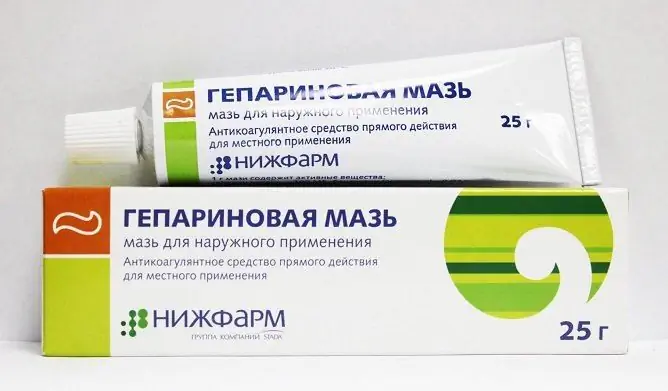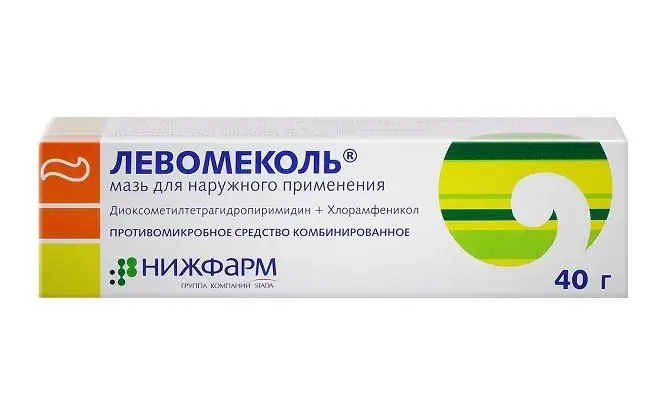- Author Rachel Wainwright [email protected].
- Public 2023-12-15 07:39.
- Last modified 2025-11-02 20:14.
Laticort
Latikort: instructions for use and reviews
- 1. Release form and composition
- 2. Pharmacological properties
- 3. Indications for use
- 4. Contraindications
- 5. Method of application and dosage
- 6. Side effects
- 7. Overdose
- 8. Special instructions
- 9. Application during pregnancy and lactation
- 10. Use in childhood
- 11. Use in the elderly
- 12. Drug interactions
- 13. Analogs
- 14. Terms and conditions of storage
- 15. Terms of dispensing from pharmacies
- 16. Reviews
- 17. Price in pharmacies
Latin name: Laticort
ATX code: D07AB02
Active ingredient: hydrocortisone butyrate (hydrocortisone butyrate)
Producer: Elfa JSC Pharmzavod (Poland)
Description and photo update: 2019-23-08
Prices in pharmacies: from 116 rubles.
Buy

Latikort is a local drug with glucocorticoid, anti-inflammatory, antipruritic, anti-exudative, anti-allergic action.
Release form and composition
Latikort is available in three external dosage forms:
- Cream 0.1%: white homogeneous mass (15 g each in aluminum tubes, 1 tube each in a cardboard box);
- Ointment 0.1%: almost colorless, transparent fatty mass (15 g each in aluminum tubes, 1 tube each in a cardboard box);
- Solution 0.1%: transparent, colorless, without mechanical impurities and sediment, has the smell of isopropyl alcohol (20 ml in polyethylene bottles, 1 bottle in a cardboard box).
The 1000 mg cream contains:
- Active ingredient: hydrocortisone butyrate - 1 mg;
- Auxiliary components: liquid paraffin - 60 mg, white petrolatum - 150 mg, cetomacrogol - 18 mg, cetostearyl alcohol - 72 mg, methyl parahydroxybenzoate - 2 mg, citric acid - 4.2 mg, sodium citrate - 2.8 mg, purified water - up to 1000 mg.
The composition of 1000 mg of ointment includes:
- Active ingredient: hydrocortisone butyrate - 1 mg;
- Auxiliary components: white petrolatum - up to 1000 mg.
The composition of 1 ml of solution includes:
- Active ingredient: hydrocortisone butyrate - 1 mg;
- Auxiliary components: povidone - 2.5 mg, glycerol - 30 mg, citric acid - 1.72 mg, isopropanol - 0.5 mg, sodium citrate - 0.78 mg, purified water - up to 1 ml.
Pharmacological properties
Pharmacodynamics
The active ingredient of Latikort is hydrocortisone butyrate - a glucocorticosteroid for external use with anti-inflammatory, anti-allergic, antipruritic and anti-exudative action, which reduces capillary permeability.
Hydrocortisone inhibits the activity of phospholipase A 2, as a result of which the synthesis of prostaglandins and leukotrienes is suppressed. The drug inhibits the migration of lymphocytes and leukocytes to the inflammation focus. Delays the growth of fibroblasts, inhibits the proteolytic activity of tissue kinins, prevents the development of connective tissue in the focus of inflammation. Reduces hyperemia and manifestations of hypersensitivity reactions. Reduces exudative and proliferative processes in the connective tissue in the focus of inflammation.
Pharmacokinetics
After applying Latikort to the skin, hydrocortisone butyrate easily penetrates into the stratum corneum of the skin, in a small amount enters the systemic circulation. The absorption of the drug increases in cases of its use on large areas of the body, application to the skin of the face or in the area of skin folds, prolonged use under occlusive dressings.
In children, absorption of the substance from the epidermis is more pronounced than in adults. Hydrocortisone butyrate can accumulate in the cells of the stratum corneum.
The drug is biotransformed directly in the epidermis, and the absorbed amount of the substance is in the liver. As a result of metabolism, products are formed - hydrocortisone and butyric acid, which are quickly excreted from the body.
Given the peculiarities of the kinetics and the absence of halogens in the formula, the risk of developing local and systemic side effects is minimal.
Indications for use
According to the instructions, Latikort is prescribed for the treatment of uninfected, sensitive to the action of local glucocorticosteroids, skin diseases that occur with excessive keratinization:
- Seborrheic and atopic dermatitis;
- Lichen planus;
- Erythroderma;
- Psoriasis;
- Contact eczema.
Also, the drug is prescribed for insect bites.
Contraindications
- Skin infections of bacterial, viral and fungal etiology;
- Syphilitic or tuberculous skin lesions;
- Perioral dermatitis;
- Acne rosacea, acne vulgaris;
- Skin tumors;
- Violations of the integrity of the skin (wounds, ulcers);
- Post-vaccination period;
- Age up to 6 months, with itching in the anus - up to 12 years;
- Hypersensitivity to drug components.
Latikort is prescribed with caution to patients with diabetes mellitus and tuberculosis (with systemic damage).
For pregnant women, the drug can be used only as directed by a doctor after assessing the ratio of potential benefits to possible risks. Laticort can be applied to small areas of the skin in a short course. In the first trimester of pregnancy, the use of the drug is not recommended.
During lactation, you can carry out short-term therapy with the application of the drug to small areas of the skin. Latikort should not be used on the skin of the breast.
Instructions for the use of Latikort: method and dosage
Latikort is used externally.
The recommended dosage regimen for adults is 1-3 times a day. A small amount of the drug should be applied with massaging movements to the affected skin. The duration of the course is 1-3 weeks. Within a week, the total dose of the drug should not exceed 30-60 g. In case of a resistant course of the disease, for example, with dense psoriatic plaques localized on the knees and elbows, Latikort should be applied under occlusive dressings.
For children, the drug is prescribed from 6 months of age. Due to the more rapid development of suppression of the function of the adrenal cortex and the likelihood of a decrease in the excretion of growth hormone when using Latikort in children, a long course should be monitored for growth, body weight, and plasma cortisol levels.
When the drug is applied to the face or under occlusive dressings (diapers, diapers), absorption occurs to a greater extent, therefore, the use of minimum doses of the drug is recommended. Therapy should be carried out for a short time and under medical supervision.
Side effects
Side effects are rare. The disorders that develop during the use of Latikort are usually reversible.
In rare cases, local reactions may occur, manifested in the form of skin irritation, as well as allergic contact dermatitis.
With prolonged therapy and / or the application of Latikort to large areas, when using occlusive dressings, in some cases, such disorders may develop as: folliculitis, acne-like changes, prickly heat, hypopigmentation, striae, secondary skin infections, hypertrichosis, skin atrophy.
Overdose
Overdose cases have not been reported with external use of hydrocortisone. With prolonged use of the drug on large areas of the skin, symptoms of hypercortisolism may develop. In this case, latikort is gradually canceled and, if required, symptomatic therapy is carried out.
special instructions
Latikort ointment is recommended for use in lichenification and subacute inflammatory conditions. It is advisable to use Latikort cream in acute inflammatory conditions with weeping.
Avoid getting the drug in the eyes.
With the development of a secondary infection of a fungal or bacterial etiology, external antibacterial or antifungal drugs should be used.
The use of Latikort on the skin of the face requires special care, which is associated with the likelihood of side effects (atrophy, telangiectasia, perioral dermatitis).
In cases where after 7 days of therapy the condition does not improve, or, on the contrary, worsens, as well as when symptoms recur a few days after the drug is discontinued, it is necessary to stop using Latikort and consult a specialist.
Despite the fact that prolonged use of high doses of the drug, especially when using occlusive dressings, can lead to an increase in the content of cortisol in the blood plasma, this is never accompanied by a decrease in the reactivity of the pituitary-adrenal system. After discontinuation of therapy, cortisol production quickly returns to normal.
The likelihood of developing side effects during the use of Latikort is lower than with therapy with halogenated glucocorticosteroids.
Caution must be observed when using the drug in patients with atrophic skin conditions, especially in elderly patients.
Influence on the ability to drive vehicles and complex mechanisms
The components of the Latikort solution, ointment and cream do not have a negative effect on the patient's psychophysical functions, in particular on the ability to drive a car and perform potentially dangerous types of work.
Application during pregnancy and lactation
In the first trimester of pregnancy, the use of Latikort is not recommended.
In the II and III trimesters, the drug can be used only as directed by a doctor who will assess the ratio of the expected benefits and potential risks. Laticort should only be used on small areas of the skin and treatment should be short-lived.
During lactation, the drug is approved for use with caution. The drug should be used on small skin surfaces for a short time. Do not apply to breast skin.
Pediatric use
Latikort is approved for use from the age of 6 months.
In children, suppression of adrenal cortex function can develop more rapidly than in adults. In addition, it is possible to reduce the excretion of growth hormone. If Laticort is used for a long time, the plasma cortisol level, body weight and height of the child should be monitored. According to the results of control studies, in which children received Latikort in different dosage forms in weekly doses of 30-60 g, no adrenal cortex dysfunctions were found.
When using Latikort on the face or under an occlusive dressing (diaper / diaper), the drug should be applied in minimal doses. Treatment should be carried out in a minimally short course and under medical supervision.
With itching in the anus, the drug is approved for use in children over the age of 12 years.
Use in the elderly
Latikort should be used with caution in elderly patients in the presence of atrophic skin conditions.
Drug interactions
Information on the interaction of Latikort with other drugs is not presented.
Analogs
Latikort analogues are: Acortin, Hydrocortisone ointment, Hydrocort, Lokoid Crelo, Lokoid Lipokrem, Korteid, Cortef, Lokoid, Solu Kortef, Efkorlin, Hayton, Sopolcort N.
Terms and conditions of storage
Keep out of reach of children at temperatures up to 25 ° C.
The shelf life is 3 years.
Terms of dispensing from pharmacies
Available without a prescription.
Reviews about Latikort
The overwhelming majority of reviews about Laticort are positive. Patients note the high efficacy of the drug in various dermatological diseases sensitive to local glucocorticosteroids, and its good tolerance.
The cost of Latikort is estimated as average (it is higher than the analogue of Hydrocortisone, but lower than the analogue of Lokoid).
Price for Laticort in pharmacies
Approximate prices of Latikorta: ointment for external use 0.1% (1 tube of 15 g) - 128-150 rubles, cream for external use 0.1% (1 tube of 15 g) - 128 rubles, solution for external use 0.1% (1 bottle of 20 ml) - 170-176 rubles.
Latikort: prices in online pharmacies
|
Drug name Price Pharmacy |
|
Latikort 0.1% ointment for external use 15 g 1 pc. 116 RUB Buy |
|
Latikort ointment 0.1% 15g tube 144 RUB Buy |

Maria Kulkes Medical journalist About the author
Education: First Moscow State Medical University named after I. M. Sechenov, specialty "General Medicine".
Information about the drug is generalized, provided for informational purposes only and does not replace the official instructions. Self-medication is hazardous to health!






